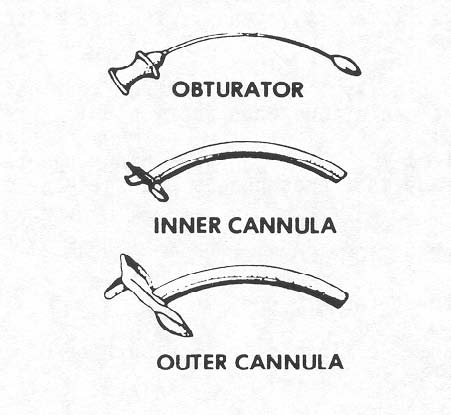2-37
2-37. TRACHEOSTOMY
a. A tracheotomy is the incision of the trachea through the skin and muscles of the neck. When an indwelling tube is inserted into the surgically created opening in the trachea, the term “tracheostomy” is used. A tracheostomy may be permanent or temporary. There are many diseases and conditions that make a tracheostomy necessary. For example, a tracheostomy may be done:
(1) To bypass an upper airway obstruction.
(2) To replace an endotracheal tube with a tracheostomy tube.
(3) To allow for extended mechanical ventilation.
(4) To facilitate removal of tracheobronchial secretions.
(5) To prevent aspiration in the comatose or paralyzed patient.
b. A tracheostomy tube (sometimes referred to as a tracheal cannula set) consists of three parts: the outer cannula, the inner cannula, and the obturator. Refer to Figure 2-3.
Figure 2-3. Tracheostomy tube set
(1) The obturator is used by the surgeon as a guide when inserting the outer cannula into the tracheal incision.
(2) After insertion of the outer cannula, the obturator is removed. The inner cannula is inserted into the outer cannula and locked in place.
(3) Tracheostomy tubes may be metal or plastic. Plastic tubes that have an inflatable cuff surrounding the outer cannula are the most commonly used. The cuff helps to hold the tube in place, prevents aspiration of material into the lungs, and prevents leaking of air around the sides of the tube.
(4) The tracheostomy tube is kept in place by means of cotton twill tape inserted through the slotted flanges of the outer cannula and tied around the patient's neck. A sterile dressing is placed around the tube to protect the stoma.


